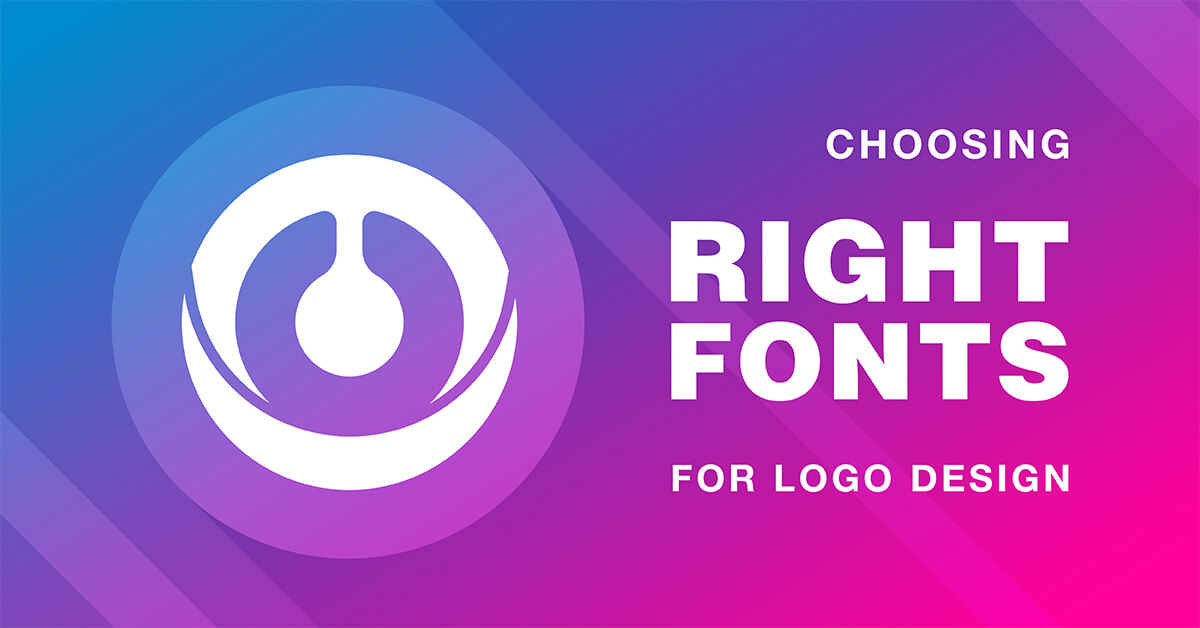
A logo is the representation of any companies. It says who you are, it features your brand identity. It’s what your targets see the most once your brand is out there in public. Colors, together with fonts, are integral and expressive elements of the logo. While a wrong choice of color can ruin logo image, bad choice of font can kill your marketing. Given the fact that there are so many fonts to choose from, it can be a challenge to pick the right font for your logo. We’ll take you through some key tips on how to choose the right one.
1. Choose a Font That Represents Your Brand
To be able to do this, brand managers or marketing managers should be able to identify the purpose of their business and their target audiences. Do their businesses target millennials or young adults? Are they talking to kids or young moms? The type of font that is used for each of these group of audiences would be vastly different.

The font that one uses for a logo of beverage brand targeting young men wouldn’t be able to use for a vintage fashion brand for middle-aged ladies. For example, Helvetica is a versatile yet simple font that can be used for many brands across industries, from airlines to technology companies, from office equipment suppliers to department stores. This ubiquitous font, however, might not be a wise choice for an energy drink brand or a funky fashion brand.
The font you choose for your logo should convey the message of your brand. When your target customers see your brand, they need to feel relevant. In other words, logo font should connect your brand with your customers. Given the important role of font type to your logo, designers and marketers need to have an agreement on brand objectives to be able to have the right font choice.
2. Choose a Legible Font
Font readability sounds like a must that all designers are aware of. It’s a common sense in logo design. However, sometimes legibility is still overlooked when it comes to choosing a font for the logo. This can happen when you let your creativity flow freely. Once you aim to differentiate yourself from a pool of competitors, you might allow yourself to go out of the box. It’s very likely that you choose a unique yet highly readable font, such as Disney font or graffiti font.
Choosing a distinctive font is great. You stand out from the crowd. But be careful! It’s important to ask yourself if that font is readable in smaller sizes. Are all letters legible? Is the font taking up too much space? The font that you choose for your logo will probably be used on different marketing materials afterward. This is something that many designers might not think of when they focus on choosing the font for their logo.

Font size does matter because your logo will probably be enlarged on a poster or a billboard while it won’t change its size that much when it sits on your business card. This means the font that you choose for your logo should be carefully considered its readability when it’s in its smallest or biggest size.
In addition, mobile devices are becoming more and more popular these days. You might have already been aware of the fact that a majority of your customers view your logo on their mobile phones every day. Testing your font readability on online design tools like DesignBold to know it works is pretty simple and easy. If it doesn’t work, you can try other options in a few clicks.
For example, old English font has been chosen by many global fashion brands, but it might not be readable when it’s in smaller sizes. Similarly, while typewriter font is really distinctive and thereby a good choice to differentiate yourself from other players in the market, it can be really hard to read.
3. Find a Balance in Combining Fonts
Choosing the right font for your logo is a mystifying process, not to mention combining two fonts in one logo. It’s tricky because if two fonts are wildly different, they can clash with each other and your logo will look messy and unrecognizable. One popular tip is combining two fonts that complement each other. This is easier said than done simply because two fonts that support each other can sometimes be very similar.

Pairing two fonts harmoniously take time. It’s a whole process of experimentation that takes lots of patience, practice, and observation. You might fail a few times before coming up with a good pair of fonts for your logo. In some cases, it’s a difficult task to decide whether two fonts are a good match in your logo. Sometimes your decision is based on your instinct or your feeling. To stay away from deciding that you might regret later and to avoid going through a painful process of trying and failing too many times, below are a few tips that you can take into consideration:
- Look for shared traits: they’re the shared qualities between two fonts that make them a good combination. They can be the height or width of the letter, the look or structure of two fonts. They can be two fonts from one font family. However, it’s important to try to put them together to see if they work well with each other. Online design tools like DesignBold can facilitate this process.
- Avoid too similar fonts: because two fonts that have no discernible differences might look like a mistake rather than a purposeful combination.
- Pick two fonts with distinct personalities: because opposites tend to attract and thus work well with each other. For example, you can pair a standard font that has a strong personality with a more conservative font. Another example is combining a chunky, bold font with a tall, thin font. This contrast might be able to create the visual attraction for your logo.
In addition, different types of logos will also require different fonts, for example, company logos will need elegant and modern fonts, but for school logos, the font needs to show Be serious, but still soft. If you are interested in school logo design services, you can refer here.
To conclude, each designer should have his/her own manner of selection of fonts and colors. Hopefully, this guide will help you choose the best fonts for your logos. Happy logo creation!





